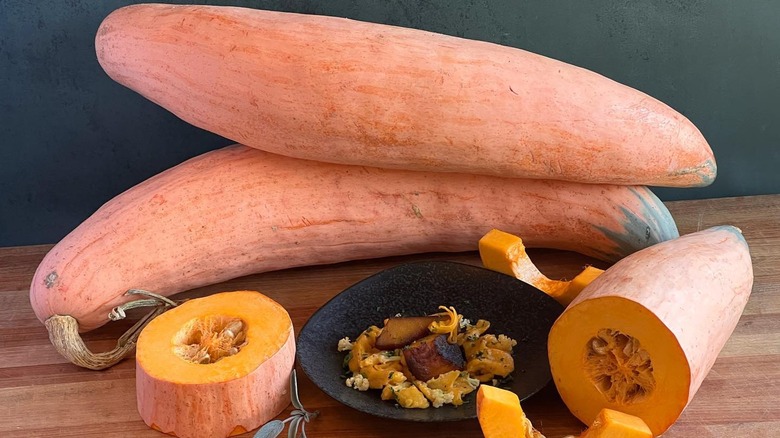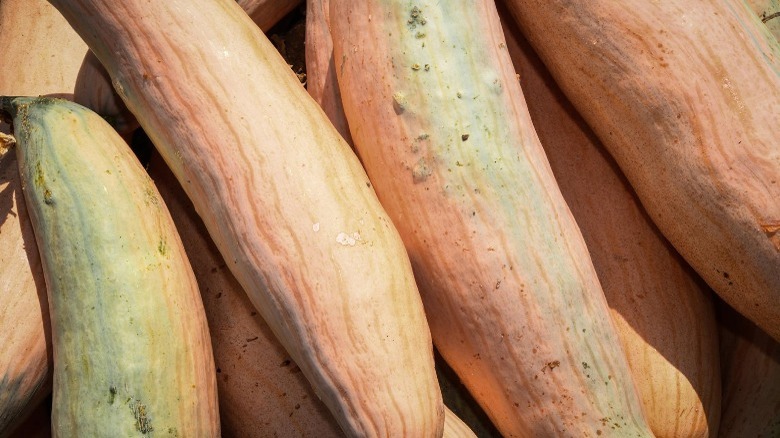Candy Roaster Squash Gets Sweeter As It Stores
If you're craving a new flavor to add to your favorite fall dishes, there's one variety of squash you might want to taste test: the North Georgia candy roaster. Its flavor is similar to that of pumpkin, though perhaps a little nuttier. It can be stored in a cool, dark place for up to six months, and the more it sits around waiting to be eaten, the more its flavor changes and intensifies. Over time, the squash will become sweeter and more pronounced in its nuttiness. So if you want to turn the squash into a pie, you'll need to snag one and give it plenty of time to sweeten up before baking it.
If you opt to fry the squash when you're ready to dig in, you might notice some browning on the exterior as the vegetable caramelizes. As the edges crisp up, the interior will take on an almost dairy-like richness with sugary, toasty notes. You can even sprinkle on some cinnamon or nutmeg to enhance the sweet flavors. However, before you get cooking, you'll have to locate this rare vegetable first.
The squash can be difficult to find
The candy roaster — also sold under the name jumbo pink banana squash — is most often harvested in the fall, but its shelf life allows it to be enjoyed practically until the next growing season. Though this squash might sound delicious enough that you'd expect it to be everywhere, you probably aren't going to find it on local grocery store shelves. If you want to try some for yourself, you'll most likely need to purchase it directly from a farm that grows it, or seek it out at local farmers' markets in and around parts of Georgia, North Carolina, and Tennessee. First cultivated by the Cherokee Nation at least two centuries ago, the candy roaster is now a regional delicacy — one that has invited growing interest from people looking to preserve what some farmers call "the best baking squash in the world," according to Edible Asheville.
One reason the squash is harder to find is due to the way that it grows. It's extremely susceptible to cross-pollination and often breeds with other types of squash to produce hybrid varieties grown within a mile, even unintentionally. This can completely eliminate the unique flavor of the candy roaster squash. To prevent this, the candy roaster must be grown far away from other squash varieties. Its preservation has become cause for concern because of this, and seeds are even kept in the Cherokee Nation's seed bank for preservation.
The variety can be a sweet swap in recipes
As Abby Landry, Slow Food Asheville's board president, told Edible Asheville, "I think some people see these squash and just think of them as decorative, but these are some of the best squash you can eat." Indeed, they work in a variety of recipes both savory and sweet, and grow to sometimes comically large sizes — up to 200 pounds, four feet long, and half a foot in diameter. The outer skin develops a pinkish-orange and greenish-blue color. According to Landry, "Candy roasters are so awesome to look at because of their shapes, their colors, their sizes."
Thanks to its substantial dimensions, one single squash can be used to make quite a few different recipes. With its sweet flavor, the candy roaster can be swapped into recipes that would typically call for sweet potatoes or pumpkin. It can be mashed up as a side dish, pureed for use in a soup, or cooked down into a spreadable condiment similar to apple butter. It's even become a popular pie filling in the Appalachian region, enjoyed as a stand-in for pumpkin or sweet potato pie on Thanksgiving. With a taste so special and nuanced, it's a good thing these squash seem to only get better with age.


